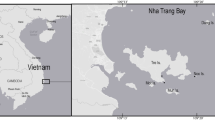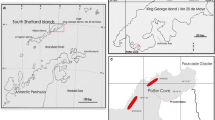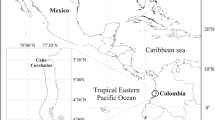Abstract
Three species of umagillid turbellarians were found to have different nutritional relationships with their echinoid hosts: Syndisyrinx franciscanus ingests host intestinal tissue and ciliates that are symbiotic in the intestine of the host; Syndesmis dendrastrorum consumes intestinal tissue and materials that have been ingested by the host; an umagillid that closely resembles Syndesmis echinorum subsists entirely on host intestinal tissue.
Similar content being viewed by others
References
Barnes, A. T., 1969. Two endoparasitic turbellarians from California echinoids. Ph.D. Thesis. Univ. of California, Santa Barbara.
Beers, C. D., 1948. The ciliates of Strongylocentrotus drobachiensis: incidence, distribution in the host, and division. Biol. Bull. 94: 99–112.
Berger, J., 1964. The morphology, systematics, and biology of the entocommensal ciliates of echinoids. Ph.D. Thesis. Univ. of Illinois, Urbana.
Boolootian, R. A., 1964. A histological study of the food canal of Strongylocentrotus franciscanus. Helgoland. wiss. Meeresunters. 11: 118–127.
Fugi, A., 1961. Studies on the biology of the sea urchin IV. Histological observation of the food canal of Strongylocentrotus intermedius. Bull. Fac. Fish. Hokkaido Univ. 11: 195–202.
Holt, P. A. & Mettrick, D. F., 1975. Ultrastructural studies of the epidermis and gastrodermis of Syndesmis franciscanus (Turbellaria: Rhabdocoela). Can. J. Zool. 53: 536–549.
Jennings, J. B. & Mettrick, D. F., 1968. Observations on the ecology, morphology and nutrition of the rhabdocoel turbellarian Syndesmis franciscanus (Lehman 1946) in Jamaica. Caribb. J. Sci. 8: 57–69.
Jenning, J. B., 1971. Parasitism and commensalism in the Turbellaria. In: Dawes, B. Ed., Advances in Parasitology 9: 1–32. New York: Academic Press.
Kozloff, E. N., 1965. Desmote inops sp.n. and Fallacohospes inchoatus gen. and sp.n., umagillid rhabdocoels from the intestine of the crinoid Florometra serratissima (A. H. Clark). J. Parasitol. 51: 305–312.
Kozloff, E. N., 1972. Selection of food, feeding, and physical aspects of digestion in the acoel turbellarian Otocelis luteola. Trans. Am. Microsc. Soc. 91: 556–565.
Leblond, C. P. & Walker, B. E., 1956. Renewal of cell populations. Physiol. Rev. 36: 255–276.
Lehman, H. E., 1946. A histological study of Syndisyrinx franciscanus gen. et sp.nov., an endoparasitic rhabdocoel of the sea urchin, Strongylocentrotus franciscanus. Biol. Bull. 91: 295–311.
Lewis, J. B., 1964. Feeding and digestion in the tropical sea urchin Diadema antillarum Philippi. Can. J. Zool. 42: 549–557.
Mettrick, D. F. & Jennings, J. B., 1969. Nutrition and chemical composition of the rhabdocoel turbellarian Syndesmis franciscanus, with notes on the taxonomy of S. antillarum. J. Fish. Res. Bd. Can. 26: 2669–2679.
Orihel, T. C., 1952. Entocommensal rhabdocoels from echinoids of Puget Sound. Master's Thesis, Univ. of Washington, Seattle.
Powers, P. B. A., 1936. Studies on the ciliates of sea urchins. A general survey of the infestations occuring in Tortugas echinoids. Papers Tortugas Lab. Carnegie Inst. Wash. 29: 295–326.
Reed, C. G. & Cloney, R. A., 1977. Brachiopod tentacles: ultrastructure and functional significance of the connective tissue and myoepithelial cells in Terebratalia. Cell Tiss. Res. 185: 17–42.
Reisman, A. W., 1965. The histology and anatomy of the intestinal tract of Dendraster excentricus, a clypeasteroid echinoid. Master's Thesis, Univ. of California, Los Angeles.
Smith, N. S., 1973. A new description of Syndesmis dendrastrorum (Platyhelminthes, Turbellaria), an intestinal rhabdocoel inhabiting the sand dollar Dendraster excentricus. Biol. Bull. 145: 598–606.
Stott, F. C., 1955. The food canal of the sea urchin Echinus esculentus and its functions. Proc. Zool. Soc. London 125: 63–86.
Tokin, I. B. & Filimonova, G. F., 1977. Electron microscope study of the digestive system of Strongylocentrotus droebachiensis (Echinodermata: Echinoidea). Mar. Biol. 44: 143–155.
Westblad, E., 1953. New Turbellaria parasites in echinoderms. Ark. Zool. Ser. 2. 5: 269–288.
Williamson, C. E., 1977. Fluorescence identification of zoochlorellae: a rapid method for investigating alga-invertebrate symbioses. J. Exp. Zool. 202: 187–194.
Author information
Authors and Affiliations
Rights and permissions
About this article
Cite this article
Shinn, G.L. The diet of three species of umagillid neorhabdocoel turbellarians inhabiting the intestine of echinoids. Hydrobiologia 84, 155–162 (1981). https://doi.org/10.1007/BF00026174
Issue Date:
DOI: https://doi.org/10.1007/BF00026174




